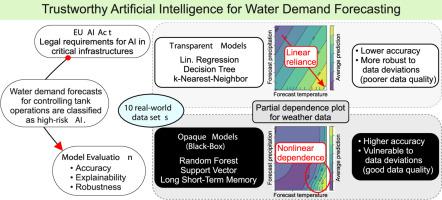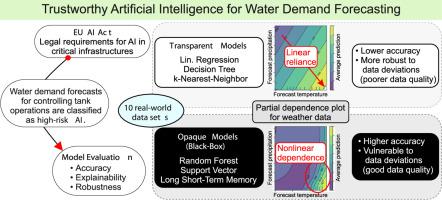Explainable artificial intelligence for reliable water demand forecasting to increase trust in predictions
IF 11.4
1区 环境科学与生态学
Q1 ENGINEERING, ENVIRONMENTAL
引用次数: 0
Abstract
The “EU Artificial Intelligence Act” sets a framework for the implementation of artificial intelligence (AI) in Europe. As a legal assessment reveals, AI applications in water supply systems are categorised as high-risk AI if a failure in the AI application results in a significant impact on physical infrastructure or supply reliability. The use case of water demand forecasts with AI for automatic tank operation is for example categorised as high-risk AI and must fulfil specific requirements regarding model transparency (traceability, explainability) and technical robustness (accuracy, reliability). To this end, six widely established machine learning models, including both transparent and opaque models, are applied to different datasets for daily water demand forecasting and the requirements regarding model accuracy, transparency and technical robustness are systematically evaluated for this use case. Opaque models generally achieve higher prediction accuracy compared to transparent models due to their ability to capture the complex relationship between parameters like for example weather data and water demand. However, this also makes them vulnerable to deviations and irregularities in weather forecasts and historical water demand. In contrast, transparent models rely mainly on historical water demand data for the utilised dataset and are less influenced by weather data, making them more robust against various data irregularities. In summary, both transparent and opaque models can fulfil the requirements regarding explainability but differ in their level of transparency and robustness to input errors. The choice of model depends also on the operator's preferences and the context of the application.


可解释人工智能用于可靠的水需求预测,提高预测的可信度
欧盟人工智能法》为欧洲人工智能(AI)的实施制定了框架。法律评估显示,供水系统中的人工智能应用如果出现故障,会对物理基础设施或供水可靠性造成重大影响,则被归类为高风险人工智能。例如,在水箱自动运行中使用人工智能进行水需求预测就被归类为高风险人工智能,必须满足有关模型透明度(可追溯性、可解释性)和技术稳健性(准确性、可靠性)的特定要求。为此,我们在不同的数据集上应用了六种广为流传的机器学习模型(包括透明模型和不透明模型)来进行每日需水量预测,并系统地评估了该用例对模型准确性、透明度和技术稳健性的要求。与透明模型相比,不透明模型由于能够捕捉气象数据和需水量等参数之间的复杂关系,通常能获得更高的预测精度。然而,这也使其容易受到天气预报和历史需水量的偏差和不规则性的影响。与此相反,透明模型主要依靠历史需水量数据来利用数据集,受天气数据的影响较小,因此对各种数据不规则性的抵抗能力更强。总之,透明模型和不透明模型都能满足可解释性方面的要求,但在透明度和对输入误 差的稳健性方面有所不同。模型的选择还取决于运营商的偏好和应用环境。
本文章由计算机程序翻译,如有差异,请以英文原文为准。
求助全文
约1分钟内获得全文
求助全文
来源期刊

Water Research
环境科学-工程:环境
CiteScore
20.80
自引率
9.40%
发文量
1307
审稿时长
38 days
期刊介绍:
Water Research, along with its open access companion journal Water Research X, serves as a platform for publishing original research papers covering various aspects of the science and technology related to the anthropogenic water cycle, water quality, and its management worldwide. The audience targeted by the journal comprises biologists, chemical engineers, chemists, civil engineers, environmental engineers, limnologists, and microbiologists. The scope of the journal include:
•Treatment processes for water and wastewaters (municipal, agricultural, industrial, and on-site treatment), including resource recovery and residuals management;
•Urban hydrology including sewer systems, stormwater management, and green infrastructure;
•Drinking water treatment and distribution;
•Potable and non-potable water reuse;
•Sanitation, public health, and risk assessment;
•Anaerobic digestion, solid and hazardous waste management, including source characterization and the effects and control of leachates and gaseous emissions;
•Contaminants (chemical, microbial, anthropogenic particles such as nanoparticles or microplastics) and related water quality sensing, monitoring, fate, and assessment;
•Anthropogenic impacts on inland, tidal, coastal and urban waters, focusing on surface and ground waters, and point and non-point sources of pollution;
•Environmental restoration, linked to surface water, groundwater and groundwater remediation;
•Analysis of the interfaces between sediments and water, and between water and atmosphere, focusing specifically on anthropogenic impacts;
•Mathematical modelling, systems analysis, machine learning, and beneficial use of big data related to the anthropogenic water cycle;
•Socio-economic, policy, and regulations studies.
 求助内容:
求助内容: 应助结果提醒方式:
应助结果提醒方式:


